Falafel Stars of the Village
10.05.07
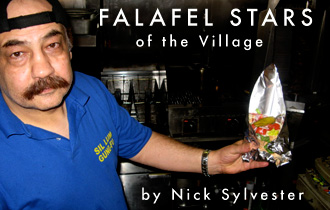 Sometime last year I developed a self-satisfying, Good Samaritan-type obsession with the Original Falafel Star on East 7th Street. I hadn’t yet seen the Seinfeld episode where Jerry untangles virtually the same knot of pathos I’m about to, so had no idea I was engrossed in what’s apparently a gastronomical banality, i.e. the delusional belief that a restaurant’s welfare depended on my good will alone. This is what I did know though. Before I had even been to Original Falafel Star, I had decided on three things. The first was: Original Falafel Star made the best falafel in East Village. The second: whoever ran the place would bear some resemblance to someone in my family. Three: I would eat here all the time. Only one of these remains true.
Sometime last year I developed a self-satisfying, Good Samaritan-type obsession with the Original Falafel Star on East 7th Street. I hadn’t yet seen the Seinfeld episode where Jerry untangles virtually the same knot of pathos I’m about to, so had no idea I was engrossed in what’s apparently a gastronomical banality, i.e. the delusional belief that a restaurant’s welfare depended on my good will alone. This is what I did know though. Before I had even been to Original Falafel Star, I had decided on three things. The first was: Original Falafel Star made the best falafel in East Village. The second: whoever ran the place would bear some resemblance to someone in my family. Three: I would eat here all the time. Only one of these remains true.
There are about twenty falafel joints in the East Village region, which I demarcate on the west by Fourth Avenue, the north by 14th Street, the south by Houston (give/take), the east by the river – 21 if you count the metal stand on (I think it’s) 11th Street and First Avenue, the one whose side reads, "BEST FLAFEL IN TOWN."
This is how falafel is made, generally speaking: Dried chickpeas are drowned in a bucket of cold water for 24 hours, then drained and re-panned. From there they’re dumped into a bowl with garlic, onion, coriander, cumin, and baking powder, then mashed into a thick paste, and from the paste, servings sized like ping-pong balls are deep-fried in oil for about five or six minutes until golden brown. A semi-respectable falafel maker will then stuff about three of these balls deep into a grilled pita coated on the inside with hummus, then add fresh cucumbers, onions, tomatoes, a dusting of some Middle Eastern spice, and a healthy ladling of white tahini sauce, which is a smooth blend of sesame seed paste and olive oil.
Obviously there is room for variety – the type, quantity and quality of chickpea and additive ingredients, the time chickpeas spend in the deepfryer, the kind and freshness and preparation of the pita bread, the places your falafel maker’s hands have been beforehand, etc. – but there’s also something rote and predictable to the sandwich. It’s a pita, it’s mostly hot, one bite and it tastes like the healthiest possible thing you could ever bite into in the shrinking $2.50-$4.50 range, the other bite it tastes like a paste of chickpeas deep-fried in grease, i.e. physically devastating. That, and falafel isn’t necessarily consumed with the gustatory expectations we bring into a Michelin-approved establishment. Like pizza, we’re often eating it mostly for sustenance, on the fly before a concert or on impulse after a night of heavy drinking. If there’s any rule, falafel just has to not taste bad.
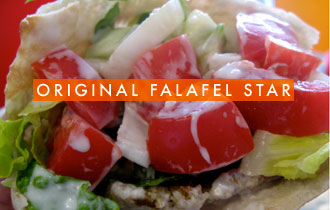 Original Falafel Star opened some time in early 2005. I tried to go there for lunch during my Voice days but found it closed until 5 or 6pm. The man who runs the OFS is named Mohamed, and has been behind one falafel stand or another, sometimes several at once, since 1976. Actually, the East Village’s Original Falafel "Star," Mohamed told me, was Mohamed himself, a way congenial Syrian man whose distended midregion, deep eye bags, permanent facial stubble and longer, mangled hair and moustache blatantly dyed red reminded me of the Original Barry Sylvester, my father. “Café Rakka come five or six years after me,” he said. I ordered a falafel sandwich, watched him put the pita on the grill and listened to him explain the rise and fall and extent of his empire, which waned, he explained, not for lack of customers but for landlords who jacked rent up an impossible 50%. Mohamed handed me my sandwich. His last location was somewhere on St. Marks apparently, and he claimed to have opened the original falafel spots inhabited by Damask on Avenue A and one called “Mohamed Falafel Star” eventually inhabited by Habib’s Place on 9th Street, plus spots on Sixth Avenue and Houston Street. Most of these no longer existed. I told him I thought his sandwich was absolutely delicious. The tomatoes were so big and fresh, the falafel somehow still moist and flavorful in layers despite the leveling deep fry. Mohamed put his hands together and bowed in gratitude. I told him I would be back and he bowed again.
Original Falafel Star opened some time in early 2005. I tried to go there for lunch during my Voice days but found it closed until 5 or 6pm. The man who runs the OFS is named Mohamed, and has been behind one falafel stand or another, sometimes several at once, since 1976. Actually, the East Village’s Original Falafel "Star," Mohamed told me, was Mohamed himself, a way congenial Syrian man whose distended midregion, deep eye bags, permanent facial stubble and longer, mangled hair and moustache blatantly dyed red reminded me of the Original Barry Sylvester, my father. “Café Rakka come five or six years after me,” he said. I ordered a falafel sandwich, watched him put the pita on the grill and listened to him explain the rise and fall and extent of his empire, which waned, he explained, not for lack of customers but for landlords who jacked rent up an impossible 50%. Mohamed handed me my sandwich. His last location was somewhere on St. Marks apparently, and he claimed to have opened the original falafel spots inhabited by Damask on Avenue A and one called “Mohamed Falafel Star” eventually inhabited by Habib’s Place on 9th Street, plus spots on Sixth Avenue and Houston Street. Most of these no longer existed. I told him I thought his sandwich was absolutely delicious. The tomatoes were so big and fresh, the falafel somehow still moist and flavorful in layers despite the leveling deep fry. Mohamed put his hands together and bowed in gratitude. I told him I would be back and he bowed again.
So began the patronage. Granted it wasn’t difficult to keep up. I was now unemployed, coasting on government dollars, plus I was only living across the street in the East Village, which apparently had outgrown me. The neighborhood had now been fully transformed into Manhattan’s gritty chic playground, with pricey small restaurants whose (I guess) "downtown charm" amounted to tables placed too closely together, long waits that ebb out onto the avenue sidewalks, more bugs visible than you’d think, and cash-only registers. Mohamed started coming in earlier for the lunch hour too; that helped. I clocked a lot of hours with him sitting outside on his bench, talking probably too openly about my personal life, ogling girls who walked down 7th Street, and silently reaffirming my initial belief that his falafels were the best I’ve ever had. "I take care of you," he’d say, which in most cases meant that he would make me a falafel sandwich, in others that he was merely reassuring me, in case I didn’t have the money for a sandwich, that he would cover me and I could get him back. As we’d sit there outside undisturbed by no customers for sometimes hours, his never-washed Mitsubishi SUV parked out in front, his two kids and wife at home somewhere in Brooklyn, a Middle Eastern vacation, and the employment of another falafel star, his longtime protégé Habib Belkadi, in the meantime – I wondered how he could possibly cover for me.
Funny word, patron. To an extent the belief that a place has, in fact, the best food, drives patronage, but in the case of OFS I had already decided that beforehand. And it’s not like I’d rather eat a falafel sandwich (which destroys my colon gas-wise like no other) over dining at Via Della Pace, the Italian place up the street. Really it’s not a convenience/thriftiness über alles situation either, since there’s both a McDonald’s and the cheap Kebab Garden on my side of First Avenue anyway, and any number of pizza places. It’s a funny word, patron, because it’s so close to patronize, territory I was constantly worried of getting into with OFS. Here were two loud personal insecurities I realized: One, this city devours secrets and ruins them more quickly than ever, and I wanted to have not the best place, just one that was my own; two, if it wasn’t my wannabe savior complex it was merely wrenched logic, but either way I felt a moral obligation to keep this man Mohamed, who looked like my father, and his family, which may or may not resemble my own, from suffering the fate that all of the East Village seemed to be suffering: not just gentrification, but a squeeze on affordability and cafe-like neighborhood commons, two things Mohamed used to provide to much more acclaim.
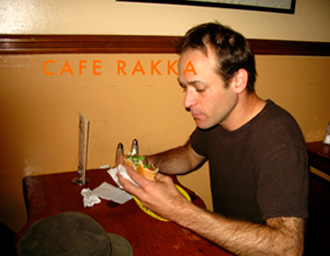 Starting ten years ago Times wino Eric Asimov wrote not one but three articles I could count about Habib’s Place, OFS cohort Habib Belkadi’s East 9th Street hotspot acquired from Mohamed (who taught Habib both falafel and English), before the East Village got turned into a fully-insured, business-class amusement park. Here’s an excerpt of one from June 16, 1999:
Starting ten years ago Times wino Eric Asimov wrote not one but three articles I could count about Habib’s Place, OFS cohort Habib Belkadi’s East 9th Street hotspot acquired from Mohamed (who taught Habib both falafel and English), before the East Village got turned into a fully-insured, business-class amusement park. Here’s an excerpt of one from June 16, 1999:
Mr. Belkadi is more than just the owner and chef of Habib’s Place. He knows almost everybody who comes in, he accepts packages for neighbors and serves meals on credit if customers are short of money. He is a particular favorite of musicians and is a jazz lover himself. Habib’s may be the only Middle Eastern restaurant in New York decorated with photographs of Louis Armstrong and Miles Davis, Thelonious Monk and Charlie Parker.
Here’s another, from June 16, 1995 (no idea what’s the story behind June 16, unless there’s a Bloomsday reference I’m missing):
Soon after, a middle-aged man comes in, uses Mr. Belkadi’s counter phone for 10 minutes, then grabs the falafel sandwich Mr. Belkadi has wrapped for him. The customer hands him an envelope and says as he leaves: "Do me a favor. Sybil’s coming by. Give her this $250, with love."
Such is life at Habib’s Place, no mere restaurant but a community gathering spot. Like a situation comedy, the entire cast of East Village seems to pass through, from police officers to street musicians. They share tables (just a dozen seats), magazines and strike up conversations over Mr. Belkadi’s beloved jazz. You almost expect a laugh track
You can also wade through the Chowhound and Post Punk Kitchen boards and find occasional shoutouts to Mohamed’s "Mohamed Falafel Star" and other falafel places since demapped, talked about in almost the same exact terms: the surprising good food considering the low price, and the community, the idea of a common "spot" that crucially wasn’t a bar or one of those cheesy cafes on Avenue A. Get on the right messageboard and it almost seems like East Village was the island’s last bastion of non-cheesy, communal cheap eats.
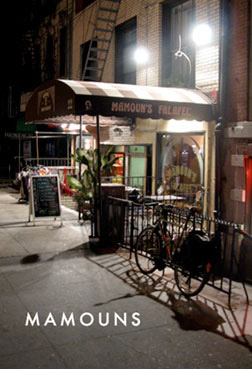 I don’t want this to turn into some whiny undergraduate social studies piece about the East Village, which I’m by no means even qualified to talk about definitively or even anecdotally. Plus I happen to love expensive restaurants. But I bring all this up because there was, even in the paper of record, a soft spot for the local importance of cheap eats. But just saying: As more New Yorkers have soaked up their new identity as fastfood-averse foodies, out for the most gloriously spectacular meal after reading your Brunis and Bufords and Bourdains eroticize the experience and knight the most expensive restaurants as standard bearers of good food, thereby pissing on mid-priced and otherwise perfectly delicious restaurants – after these clowns have turned eating into such an event that any food that isn’t eventful is heretofore unedible—as that’s happened, we’ve seen just-as-important cheap-eats hangouts bite the bedbug.
I don’t want this to turn into some whiny undergraduate social studies piece about the East Village, which I’m by no means even qualified to talk about definitively or even anecdotally. Plus I happen to love expensive restaurants. But I bring all this up because there was, even in the paper of record, a soft spot for the local importance of cheap eats. But just saying: As more New Yorkers have soaked up their new identity as fastfood-averse foodies, out for the most gloriously spectacular meal after reading your Brunis and Bufords and Bourdains eroticize the experience and knight the most expensive restaurants as standard bearers of good food, thereby pissing on mid-priced and otherwise perfectly delicious restaurants – after these clowns have turned eating into such an event that any food that isn’t eventful is heretofore unedible—as that’s happened, we’ve seen just-as-important cheap-eats hangouts bite the bedbug.
New York famously has more restaurants than days in a lifetime ("you could go to a new one every day," etc.), many of them excellent. So what freaks me out even more than good writers with sizable budgets writing about food are bad writers with no budget writing about food – i.e. the rash of food blogs in the last year. Most make one night of one restaurant, not many of one, and have no qualms making snap albeit enormous judgments about an establishment based on one meal. I’ve been in the biz. Less so at quality restaurants, there are innumerable things that can and will get fucked up at any given meal, on both sides of the table. But instead of a synthesized take over a few meals on different nights, we get flash judgements and outright idiocy, cf. a Menupages.com full of restaurants that are simultaneously the best and worst places to take a date, for instance, or people who complain that WD-50 was not a bargain. Everybody eats, but that doesn’t mean everybody’s a food critic. To say nothing of the fact that already your Eater.com-type blogs have an intense dislike for the sacred cows of the NYC restaurant world, the city’s Old Media of Food, and increasingly these people go out of their way to knock them down in hopes of anointing a young restaurant the New Best, which throws off objectivity in ways that have affected pretty much any publication that’s positioning itself as a tastemaker. Etc.
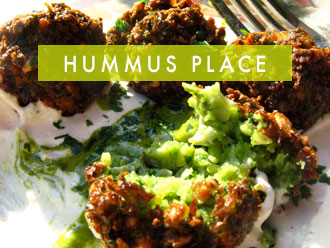 So back to OFS: Was it the best? I spent some time sampling almost all the falafel places in East Village, not really chasing authenticity since I have no idea what an actual falafel’s supposed to taste like, just following a curiosity racked with a suspicion that in the case of falafel, I was a hurdle for my own critical sensibilities. Chickpea on Third Avenue, whose patrons proudly remind each other that the place is owned by McDonald’s, is truly awful: really dry falafel that just sits there in a metal bucket if customers don’t order it for a while, flaccid vegetables, no fresh tomatoes, soft puffy pita bread that’s made on premises but tastes fastfoody and is difficult to digest, a long line of NYU kids, and a $4 price tag. Cinderella’s on Second Avenue has falafel balls that are so rockhard it’s unclear how much is chickpea and how much is oil; Cafe Rakka and Mamoun’s, both of St. Marks, whip up hot and delicious falafel balls with fresh vegetables and grilled pita bread; Scarface Cafe on 4th Street, which was named after exactly who you think it was named after, used fava beans instead of chickpeas to make the falafel balls, and no longer exists; Hummus Place on St. Marks had by far the most intricately flavored falafel balls, the spices and flavors whirling around, taking turns in the spotlight but never losing sight of their chickpeaness; Damask on Avenue A used ratty vegetables and tasted pretty uninspired; the "BEST FLAFEL IN TOWN" stand did not have the best “flafel” in town, or falafel, which tasted pretty dry and bready.
So back to OFS: Was it the best? I spent some time sampling almost all the falafel places in East Village, not really chasing authenticity since I have no idea what an actual falafel’s supposed to taste like, just following a curiosity racked with a suspicion that in the case of falafel, I was a hurdle for my own critical sensibilities. Chickpea on Third Avenue, whose patrons proudly remind each other that the place is owned by McDonald’s, is truly awful: really dry falafel that just sits there in a metal bucket if customers don’t order it for a while, flaccid vegetables, no fresh tomatoes, soft puffy pita bread that’s made on premises but tastes fastfoody and is difficult to digest, a long line of NYU kids, and a $4 price tag. Cinderella’s on Second Avenue has falafel balls that are so rockhard it’s unclear how much is chickpea and how much is oil; Cafe Rakka and Mamoun’s, both of St. Marks, whip up hot and delicious falafel balls with fresh vegetables and grilled pita bread; Scarface Cafe on 4th Street, which was named after exactly who you think it was named after, used fava beans instead of chickpeas to make the falafel balls, and no longer exists; Hummus Place on St. Marks had by far the most intricately flavored falafel balls, the spices and flavors whirling around, taking turns in the spotlight but never losing sight of their chickpeaness; Damask on Avenue A used ratty vegetables and tasted pretty uninspired; the "BEST FLAFEL IN TOWN" stand did not have the best “flafel” in town, or falafel, which tasted pretty dry and bready.
It goes on. The conclusion was: Hummus Place had the best falafel. I was pretty bent out of shape about this, in no small part because a certain lady I spend a lot of time with cannot and will not stand for meals at Hummus Place. I’d have to be going here on the sly, which means that there would be two other people I’d be hiding from: Habib and Mohamed. Habib I had developed a pretty tight relationship when Mohamed left. At nights he played a cassette tape of some radio show hosted by some jazz saxophonist who used to eat in his old restaurant, Habib’s Place, and at one point the saxophonist talked about Habib and Habib’s Place extensively on air. There Habib would stop whatever he was doing and start shouting and pointing to the boombox and making sure that I listened, as if to say, "I wasn’t making this up. I had this incredible place and people loved it and it’s no longer there." The tape is about 10 years old. Habib played it at the OFS constantly.
So maybe it’s a character thing too. The whole neighborhood seems so rootless now that anything or anyone with any semblance of permanence or any longview has something palatial to it—something that has nothing to do with patronage or patronizing or food at all. One of the nights post Ramadan, which is this 30-day Islamic fast that begins late September, Mohamed and I were sitting outside right before dark, smalltalking with landlords Mohamed somehow knew, talking about girls who walked by us on the street, many of them Mohamed’s customers. "She good for you," Mohamed said to me, hinting at a tall vintage-looking girl with lots of blond hair and no butt. Mohamed said this to me about any tall vintage-looking girl with no butt. "Me," he continued, "big, healthy," gesturing to his chest, then his bottom. We both laughed and looked at each other and I realized: This man doesn’t look like my dad at all.